A 1935 dollar bill may be a small deal to you. But if that dollar bill includes a few key markings, it may be worth more than its face value.
Some 1935 dollar bills have sold for tens of thousands of dollars.
Knowing its value and distinctions are vital to capitalizing on rare dollar bills.
To truly understand why specific 1935 one-dollar bills are valued so high, we have to look at its history and changes from the previous 1934 issue.
Little-Known Facts About 1935 Singles –
Some U.S. citizens had issues with the Fourth Coinage Act and the gold standard. As a result, Silver Certificates were issued and redeemable for silver dollar coins and silver bullion.
More than 38 billion one-dollar silver certificates were printed by the U.S. Government. After the 1935 silver certificate, it wouldn’t be until 1953 that another series would be released in $1 denominations.
A 1935 silver certificate Star Note in Grade 67 is valued at about $1,000. In Grade 66, values are roughly $500.
The most valuable 1935 error silver certificate sold for over $8,200. The error note has an additional overprint with a BEP Rejection Mark.
The Hawaii Note from 1935 is valued at $2,000 in excellent condition. A North African Silver Certificate sold for nearly $2,200 in MS64-graded condition.
History of the $1 Bill
Before 1928, all U.S. currency was printed in large size, with 7 3/8″ x 3 1/8″ dimensions.
In 1928, small-size notes were issued with dimensions of 6.14 inches x 2.61 inches.
The 1935 U.S. one-dollar bill was the first of its kind after changing its look from the 1934 dollar bill.
Both were paper money, but the 1934 version still featured something from the 1928 silver certificate that wasn’t desirable.
This was called “The Funny Back Design.”
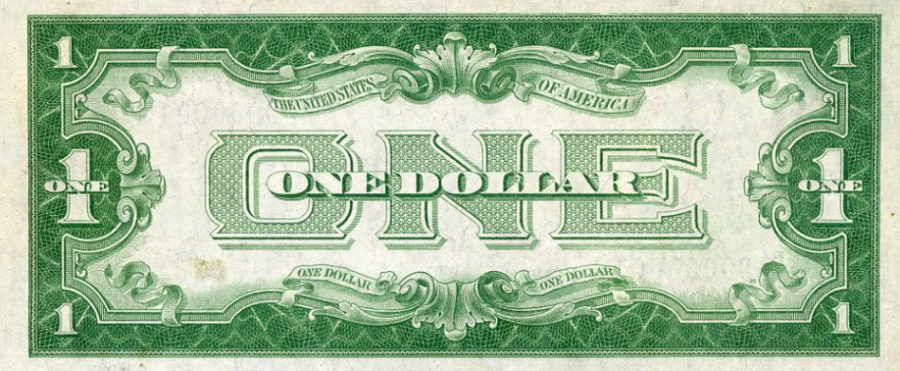
The Funnyback or Funny Back features a unique design on the back of the bill that displays the word “ONE” in a huge font, unlike any other writing on the bill.
The president’s portrait on the other side was of George Washington.
But both 1928 and 1934 silver certificate bills are considered funny backs. And both versions are not worth more than their face value.
But the 1935 dollar bill changed that when they altered the design.
Beginning of the 1935 One Dollar Bill
The first noticeable difference was the changes to the back of the bill. The face still featured President George Washington.
The only change to the front of the bill was a numerical “1” placed to the left of Washington.
However, the back of the bill went under some design changes.
Reverse Design
This particular dollar bill within the U.S. Currency featured what is known as the “All Seeing Eye” that sat at the top of a pyramid on the left side of the “ONE.”
And to the right of the printed “ONE” was the Great Seal.
The Great Seal and The Blue Seal
The Blue Seal is commonly interchanged with the Great Seal, showing that it was a Silver Certificate.
Since these notes were issued during The Great Depression and under difficult circumstances in the economy, silver certificate holders had rights to redeemed for actual silver coins or silver bullion.
Then, an Act of Congress discontinued the redemption rule in 1963.


What Makes the 1935 Dollar Bill So Valuable?
What makes the dollar bill worth anything?
Well, that’s a more extended discussion, but a significant factor is the note certifies there is silver on deposit in the Treasury, guaranteed by the United States.
What makes one dollar bill more valuable than another dollar bill? That’s a more straightforward discussion.
The 1935 one-dollar silver certificate ended up having several varieties printed at once.
To find its value, first, you should identify the bill series of the money.
How Much Is A 1935 $1 Bill and Its Varieties Worth?
The seals on the dollar bill often indicate what that bill was valued for. The silver certificates featured the Silver or blue seal.
And in the old days, because you could exchange them for silver coins, some people cut them in half to make change.
The paper certificate could tear easily, so they ripped them in two.
The North Africa 1935 Dollar Bill and The Hawaii 1935 Dollar Bill had different seals and would be two notable distinctions of the series.
North Africa 1935 $1 Bill
North African notes were distinguishable due to their yellow seal compared to other varieties.
The North African stamped notes were issued for commerce and business for trade to the U.S. military during World War II.
144,000 North Africa star notes were printed and now sell for over $1,500 each in MS 63 grade.
North African 1935 Bill Value
In uncirculated condition, the North Africa 1935 dollar bill has sold for a few thousand dollars.
If they were to have a C grade on the Sheldon scale, this could stand for two things.
The first was “Choice,” and the second was “Crisp.”

The Hawaii 1935 $1 Bill
The Hawaii 1935 Dollar Bill was issued after Pearl Harbor and during WWII.
They didn’t have blue or yellow seals but instead had a brown seal or a red seal on the note.
There’s one theory on why Hawaii notes were printed.
If Japan invaded Hawaii and confiscated U.S. currency, the U.S. government could declare all 1935 dollar bills with a Hawaii stamp invalid for cash or to finance investment.

While it isn’t among the most popular vintage collector’s items, auction listings are between $500 and $1,000 in great condition.
Over 200,000-star notes with the Hawaii stamp were produced and can bring a price of up to $2,000 in MS 63 grade in the auction market.
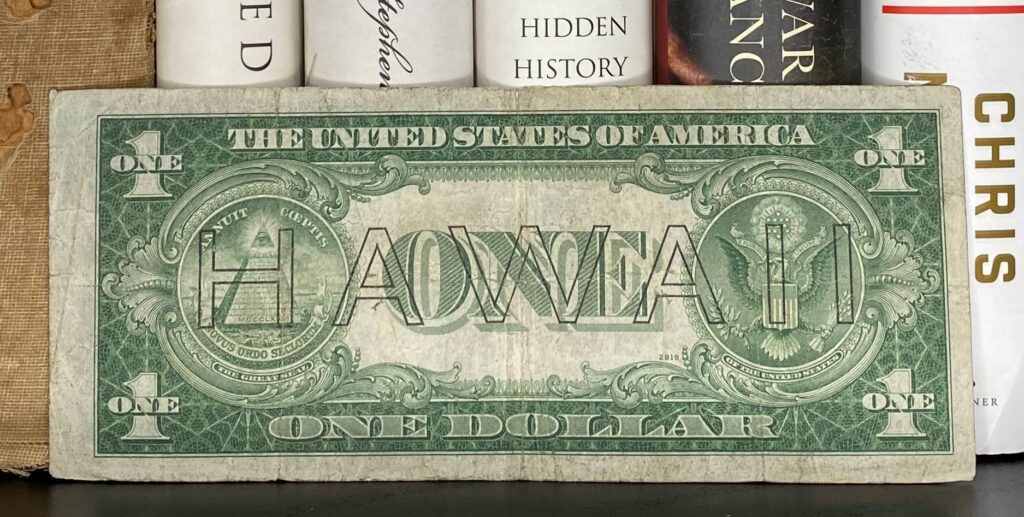
The 1935A Series
Notes of any value have to be signed by The Secretary of the Treasury.
In 1935 this happened to be Henry Morgenthau Jr. and Treasurer W.A. Julian.
It’s common for an entirely new bill design to come out. But when a term ends and a new Secretary of Treasury takes over in Washington D.C., the signature changes and slight designs are also made on the bill.
But in 1935, they were only minor.
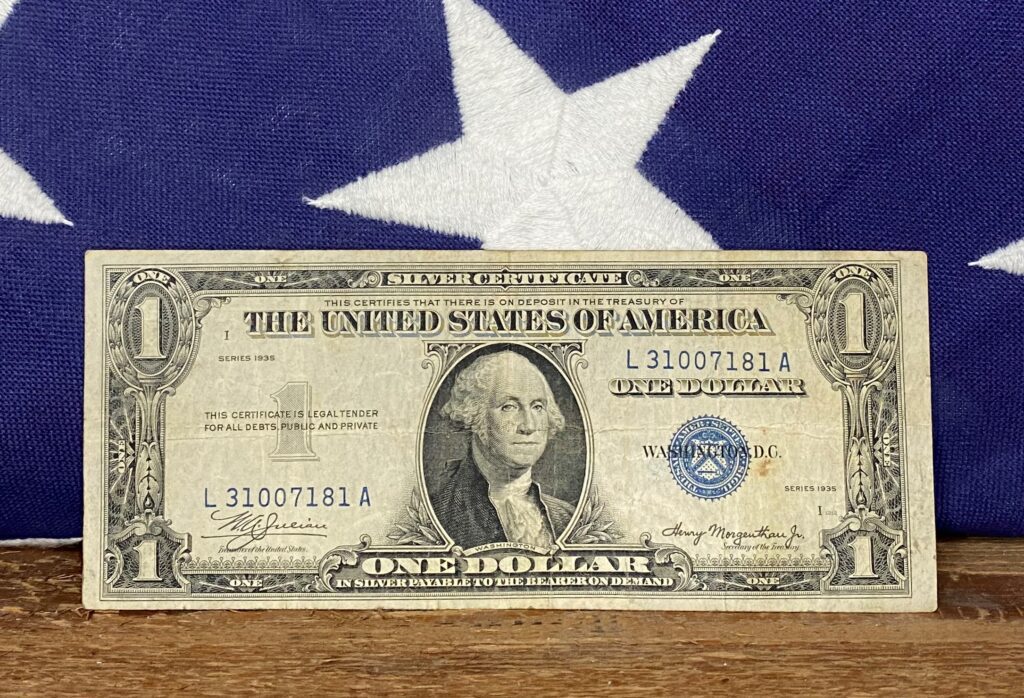
First came the 1935 A series, which features changes in the font size on the bill.
The plate numbers on the back and face of the bill were incorrectly measured, dating back to the 1928 funny back.
They were a ½ millimeter to a whole millimeter too small.
The result was enlarging the plate numbers to be readable without a magnifying glass.
1935-B Series
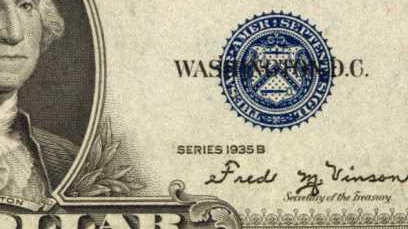
1935-C Series Bill

1935-D Wide Border Bill
The wide border 1935D dollar bill has almost twice the green space on the top and bottom of the bill relative to the narrow version.
The 1935-D series was printed from 1949 to 1953, and the earlier bills had a wide green area at the top and bottom reverse of the bill.

1935-D Narrow Border
The back design on the Series D notes was made 3 mm narrower as an experiment.
To reduce the number of miss-cuts, the printed area was reduced.
Billions of the newly spaced bills were printed, and most are worth only face value unless there is a unique or desirable serial number combination.
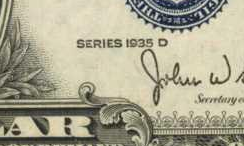
1935-E
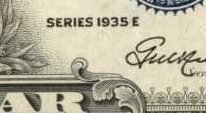
1935-F Series
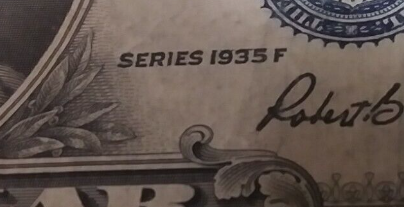
1935-G Dollar Bill – Motto & No Motto

1935-H $1 Bill
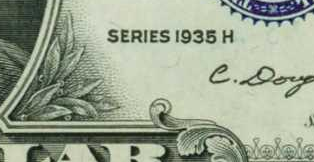
1935 $1 Bill Valuable Errors
- One of the most familiar traits of the U.S. Paper Money is the quote, “IN GOD WE TRUST.” So, naturally, with its absence on the 1935 1 dollar bill, collectors deemed this an interesting mistake.
- Oddly, the motto didn’t appear on the dollar bill until 1957. There’s one exception, though. The 1935G had the motto! Then the 1935H didn’t. The H series would be the last before the 1957 series came out with the motto.
- Signatures also featured some weird mistakes on the 1935 silver certificate. Often they would be out of order. The 1935 one-dollar bill saw series A through H often feature non-chronological signatures.
1935 $1 Star Notes
Some 1935 dollar bill notes can get up to 16,000 times their value with high grades.
If you’re thinking about purchasing old paper currency, understanding the grades is key to identifying the cost of your future collectible.
However, an uncirculated, mint condition 1935 dollar bill note is among the rarest 1935 dollar bills and gets the highest value.
Replacement Notes
Star Notes were often called Replacement Notes.
The idea seems counterintuitive, but these notes were meant to replace any dollar bills damaged during the minting process.
What defines these certificates is the asterisk next to the serial number.
We mentioned the note series only went from A to H. But the replacement notes had something different.
They also had R, and S. R meant the note was used on standard printing paper. But S meant it was an experiment.

Keeping the Banknote in Circulation
At this time in America, many collectors and everyday Americans didn’t hurry to get rid of their original 1935 one-dollar bill.
Even if you couldn’t read the back plate numbers, the issue seemed insignificant enough to eliminate the legal tender paper money.
Bureau of Engraving and Printing
And on top of that, even though the 1935A was being distributed, The Bureau of Engraving and Printing was still making the original 1935.
The confusion would see interchangeable and mixed-up back plate numbers where the original series was sometimes larger plate numbers.
The new 1935A also featured smaller plate numbers.
Plate Number Errors
This led to an interesting mistake. Notes with the wrong size plate numbers were referred to as MULES.
It prompted the creation of the 1935B and several other varieties.
And also led to the intrigue of rare coin and currency collectors and the increased values of the 1935 dollar bill.
Graded 1935 One Dollar Bills
To have a serious dollar bill and paper currency collection, you’ll want to graded and certify them.
It’s the first step in determining the value of your 1935 dollar bill, Federal Reserve Notes, or any currency notes and collector stock certificates.
PMG Grading Service
PMG, the largest and most well-known paper money grading service, has graded and certified over 8 million notes and counting.
It’s the official grading service of the American Numismatic Association (ANA) and the Professional Numismatists Guild (PNG).
Paper Money Guaranty (PMG) uses a scale of 4 to 70 to grade bills and notes.
For example, a score of 8 which was vg, or very good, to a 20 score of vf, or very fine. The scale moved up to ms, or mint state with a grade of 60 to 70.
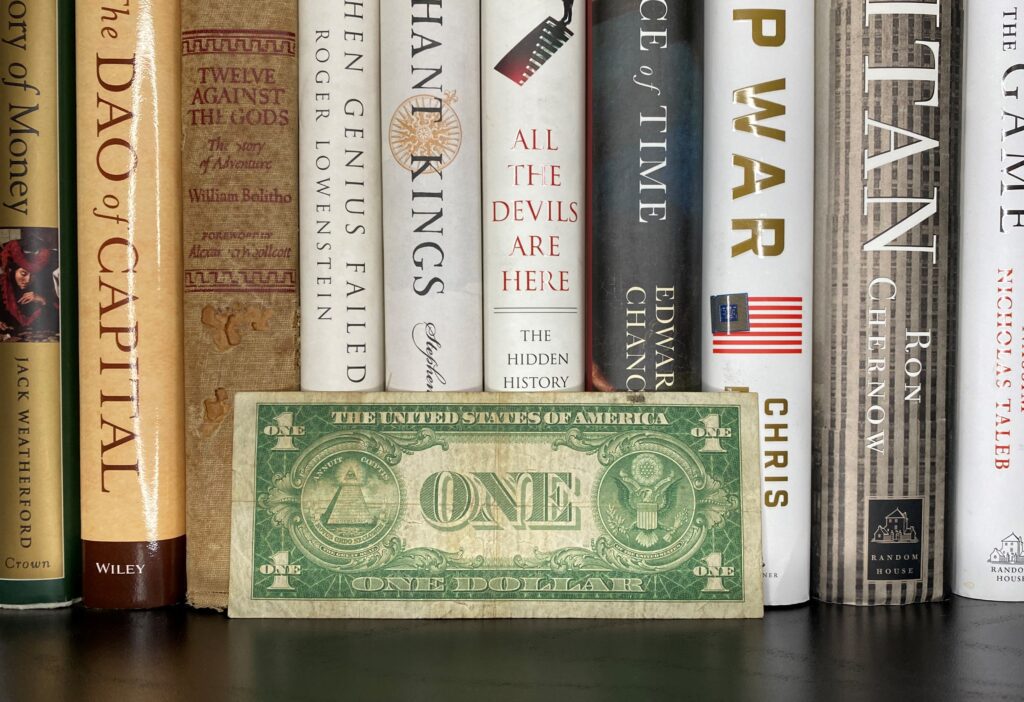

PCGS Banknote Grading
Between “Fine” and this, there are more than 50 different grading scale options. You can find that by searching the PCGS Banknote Grading.
Collectors of rare old coins and paper currency love the 1935 dollar bill. It has a great story, plays a big part in American history, and has several variations for collectors.
What We’ve Learned About the 1935 One $ Bills
Our Content Covered –
- U.S. paper currency changed in 1928. From large size dimensions to smaller, 6.14″ x 2.61″ sizes.
- The 1935 dollar bill design changed from the Funny Back to the “All Seeing Eye.”
- 1935 North African dollar bills were issued to the U.S. Military during WWII.
- Star notes, otherwise known as replacement notes, included an asterisk next to the serial number.
Learn More About U.S. Coins and Paper Currency –
- Don’t feel like driving to your local coin shop? How to sell coins online.
- How much is my coin worth? Find out how to value your collection.
- What are the basics of U.S. coinage?

